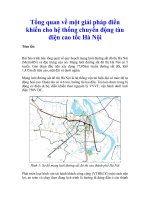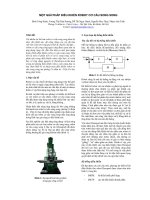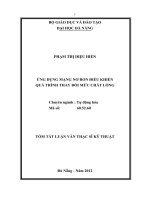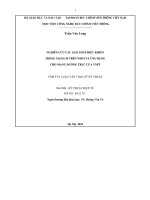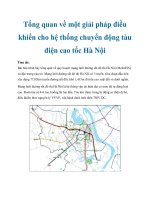VỀ một GIẢI PHÁP điều KHIỂN QUÁ TRÌNH TRAO đổi NĂNG LƯỢNG hãm của tàu điện ĐƯỜNG sắt đô THỊ VIỆT NAM tiếng anh
Bạn đang xem bản rút gọn của tài liệu. Xem và tải ngay bản đầy đủ của tài liệu tại đây (1.05 MB, 42 trang )
1
INTRODUCTION
1, The urgency of the thesis: Electric transportation with outstanding advantages is
the ability to transport large passengers, reduce environmental pollution, reduce
traffic congestion [63,78]. In Vietnam, the planned urban railway network in the near
future has 5 routes deployed in Hanoi city 6 routes in Ho Chi Minh city. However, the
energy required to operate urban railway is up to billions of kWh. Therefore, the goal
of energy saving on train operation is a very urgent issue, with high scientific and
practical significance, but so far, no research group in Vietnam has proposed energy
saving solutions. operate urban electric trains. Therefore, the author selected the
topic with the name: "About a solution to control the energy exchange process of
Vietnam urban railway electrified trains" with the aim of saving energy by a solution
for regenerative braking energy when the train operates in braking mode and in
combination with the optimal theory of determining the optimal train speed profile.
2. Research objectives: Introducing energy saving solutions in electrified train
operation. Thereby, proposing solutions suitable to the characteristics and conditions
of Vietnam's urban railways; and applying these solutions for Cat Linh-Ha Dong
urban railway to assess saving energy.
3. Research objects: Urban electric trains have traction drive system integrated with
supercapacitor energy storage device.
4. Research content: The thesis structure consists of 4 chapters
- Chapter 1: Overview of braking energy recuperation solutions: Synthesizing,
analyzing previously published works, thereby proposing research directions,
research objects, and developing solutions to solve research problems.
- Chapter 2: Implementation of modeling of electric train and supercapacitor energy
storage system.
- Chapter 3: Strategies for optimal control of train operation energy with trains
integrated supercapacitor energy storage system (SCESS).
- Chapter 4: Verification of the correctness of theoretical research through simulation
results on Matlab software with parameters of Cat Linh - Ha Dong urban electric train
line, and an experimental part of Interleaved DC -DC converter in SCESS.
- Finally, some conclusions and further research directions of the thesis are
presented in the conclusions.
5. The novelty of the thesis:
Proposing SCESS on board integrated with traction motor drive system via
Interleaved bidirectional DC-DC converter and designing supercapacitor control
according to the operation characteristics of a railway vehicle.
Applying Pontryagin's maximum principle to find optimal transfer points of
operating modes, determine the optimal speed profile of train operation using
supercapacitors on board.
2
CHAPTER 1. OVERVIEW OF SOLUTIONS FOR BRAKING ENERGY
RECUPERATION
1.1 The announced researches on solutions for braking energy recuperation
1.1.1. Domestic research
This is a very new field in Vietnam, so there are very few studies on optimizing the
energy of urban electric train operation [60].
1.1.2. Overseas research
Energy -efficient
operation of electrified
train
Optimal
speed profile
Hình 1.7. Strategies for effective management of train operation energy
Studies have shown that there are two groups of solutions with higher energy-saving
percentages: Regenarative recuperation solutions and energy efficient driving
solutions [31].
1.1.2.1. Research on regenrative braking energy recuperation
a) Regenerative braking energy recuperation by energy storage device
The supercapacitor energy storage system (SCESS) is installed onboard, at the
traction substations, or at points along the train track to recover regenerative braking
energy when the train operates in traction mode [9, 12, 21, 25, 44, 45, 46, 53, 58, 66,
68, 69, 72, 73, 75].
b) Reversible substations
Traction substations use active rectifiers for bidirectional energy flow to recuperate
braking energy up to 18% [86], [22].
c) Braking energy recuperation by timetable optimization: This solution does not
require additional investment in infrastructure of the route, with the idea of using
regenerative braking energy from a train operating in the braking mode to switch to
trains operating in accelerating mode.
Typically, Subin Sun (2017) [71] combines the operation of two trains in the same station,
recuperating the regenerative braking energy represented by the power q (t ) in
the motion equation:v
dx
With braking mode occuring in interval [tb, tc],
3
1.1.2.2. Energy - efficient driving
a) Determining the optimal train journey on the route
- The research team of the University of South Australia including Howlett, Benjamin,
Pudney, Albrecht, Xuan has determined the optimal speed profile through finding the
optimal transfer points with 5 control rules taking into account the actual conditions
on the route. such as the slope, the speed limit, etc., it is possible to find the optimal
time and distance at each train operation mode.
Comment: The research team of the University of South Australia in published
studies does not mention the problem of train running on time.
Hai Nguyen (2018) [2] applied PMP to trains with long-distance diesel locomotives,
found the optimal speed profile corresponding to the lines with different slopes, and in
the objective function also mentioned to the station problem on time.
Comment: In his thesis, Hai Nguyen does not mention the problem of recovering
braking energy.
1.2. Selecting the research direction and the tasks solved of the thesis
Through analysis of published works, there are no works that combine both the
regenerative braking energy recuperation solution by ESS and the optimal speed
profile determination with the on-board ESS while ensuring fixed trip time.
Therefore, the author proposes the selected structure for research.
Braking energy
recuperation
Technology
Traction
substation
DC
Link
ESS
VSI
Voltage
source
inverter
IM
Train
Wheel
Fig. 1.14. The selected structure for research
Technology: Learning about technology of electric train operation in some urban
railway lines in Vietnam; namely, urban railway of Cat Linh - Ha Dong line.
Energy conversion system on electric trains: focusing on studying Interleaved
DC-DC converter in an effort to ensures energy exchange between
supercapacitor and traction drive system.
Control strategies: Proposing the control method for Interleave DC-DC converter
ensures the charging-discharging mode of supercapacitors suitable for train
4
running characteristics. Proposing PMP to determine the optimal speed profile
for train operation.
Conclusion of chapter 1
By synthesizing and analyzing a number of domestic and foreign research works on
energy saving solutions, the author has analyzed and selected the research object as
an urban electric train integrated on-board SCESS and proposed independent control
strategies for each train; proposed to control regenerative braking energy
recuperation by managing the charging / discharging mode of supercapacitors; using
Pontryagin's maximum principle to optimize train operation energy with hybrid power
systems. These suggestions will be verified by MATLAB simulation software.
The summary content of Chapter 1 has been published by the author in the work [3].
CHAPTER 2. MODELING ELECTRIC TRAIN AND SUPERCAPACITOR ENERGY
STORAGE SYSTEM
The accuracy and characteristics of the mathematical model is the core factor
determining the quality of the system. So in Chapter 2 centralized modeling system
including:
Modeling lectric train
Modeling supercapacitor enregy storage system.
R
day
Substation
R
E
tdk
tdk
Fig. 2.1 Electrical drive configuration equipped with SCESS
2.1. Modeling electric train and SCESS
2.1.1. Modeling electric train
Modeling the train needs to calculate the forces affecting train motion, the traction
motor drive system to make the wheel movement.
2.1.1.1. The forces act on the train
The forces acting on the train include: The main resistance force including wind
resistance (Fwind), rolling friction resistance (Froll); slope resistance (Fgrad).
5
The third rail, 750
VDC
Feeder
Air resistance force
Train
IM
force
Fig 2.9 Diagram of forces acting on electric train [1]
Traction / braking force:
Fig. 2.11 Traction force /01 motor
Fig. 2.12 Electric braking force/01 motor
Fig. 2.14 Electric braking force regression/
01 motor
Resistance forces:
FTr
Faero
mgsinα
Froll
α
mg
Fig. 2.16 Forces acting on train
a. The main force W0 : The main resistance force (also known as basic resistance
force) includes wind resistance and friction force
6
W =F
0
+F
wind
roll
The wind resistance force depends on train speed, size and shape, represented
by the formula [93]:
1
F
=
wind
2
rC d Af
Where: r is the air density; Cd is the air drag coefficient, determined by train shape;
Af is the largest section of the train; v is train speed; vwind is wind speed; b is the sharp
angle created by the direction of the wind velocity with the movement of the train.
Rolling resistance force Froll
For simplicity, consider rolling frictional force only on hard track and consider the
ideal case that all wheels have the same conditions. At this time, rolling friction
force can be calculated as follows [93]: Froll = fr mg cos a
where fr is rolling resistance coefficient
b. Gradient resistance force Fgra d : When the train operates on the slope, the gradient
resistance force is calculated according to the formula [93]: Fgrad = mg sin( a)
where: sin(a) = sin(arctan(ik ))
ik
(‰)is the ratio of slope height to slope, a is the slope of the track.
2.1.1.2 Dynamic equation of the train
The motion equation of the train is often transformed into its own form of impact force
converted into the mass unit of the train as follows:
ì
ïdt
ï
ï
ï
ídx
ï
ïv
îï
ï
In the (2.7): utr và
(2.7)
- u br fbr (v ) - w 0 (v ) - fgrad (x)
ubr are control variables:u tr =
utr Î [0,1], ubr Î[0,1];
The unit main resistance force (also called the unit basic resistance force) is represented
by the David equation: w 0 = a + bv + cv2
The a,b,c coefficients are supplied by the Manufacturer
2.1.1.3. Motion equation of tractive electrical motor
Tel - TL
The inertia torque of the train is calculated [59]: Jeq =
Load torque when the motor operates in engine mode [59]
=J
7
(2.11)
TL
Load torque when the motor operates in generating mode [59]:
(2.12)
T=
L
2.2 Supercapacitor energy storage device modeling
Interleave DC-
Modeling energy storage device includes supercapacitor modeling
and DC converter modeling.
2.2.4 Supercapacitor modeling
Supercapacitors replaced by equivalent electrical circuit model include many parallel
branches [32]. Two RC branches provide two time constants to describe the fast and
slow dynamics.
iL
v
sc
Ii
Ci
Ri
Ci0
Ci1
(a) (b) Fig 2.22. Simple equivalent
supercapacitor circuit
As the above analysis, supercapacitor dymamic is considered for a short period of time,
ignore the Rd , Cd branch (with a minute time constant) and the branch containing RP
(characteristic for long-term leakage current in self-discharge) as shown in Figure 2.22b.
See the two capacitors with equivalent capacitance Ci depending on the voltage ui in
relation: C i (u i ) = C i 0 + C i 1 = C i 0 + k v .ui
Given Ci=Csc, ui=usc, Ri=Rsc
The mathematical model of supercapacitor is shown as follows:
ì
ï
ï
(2.21)
ï
ï
ïusc
(0)
ï
ï
ïp (t )
îï
SC
(2.22)
2.2.5. Interleaved DC-DC converter modeling
Non-isolated bidirectional DC-DC converter consists of parallel branches (also called
Interleave DC-DC converter) suitable for high-power, high-voltage drives.
2.2.5.1 Power circuit structure of Interleaved DC-DC converter with three switch
branches
Supercapacitor performs the process of energy charging / discharging through the
Interleaved DC-DC converter with three switch branches as shown in Figure 2.24.
8
Source
Electric
Rectifier
AC
DC
SCESS
Converter
DC
SC
DC
HB1
HB2
SBK1
SC
3
SBK2
DBS3
DBS1
iL
HB
RL1,L1
CDC
RL2,L2
UDC-link
RL3,L3
Csc
usc
SBS1
SBS2
DBK1
DBK3
R
SC
Fig. 2.24. Power circuit structure of Interleaved DC-DC converter
The configuration of Interleaved DC-DC converter includes half-bridges (HBs) in
parallel, as shown in Figure 2.24 with three parallel H-bridge halves: HB1, HB2, HB3.
In order to SCESS charges/discharges according to the train characteristics, the
Interleaved DC-DC converter needs to work in two modes: Boost mode, Buck mode.
2.2.5.2. Modeling bidirectional DC-DC converter with one switch branch
The Interleaved DC-DC converter operates with assumptions: IGBTs are ideal,
converter operates in continuous current mode; conventionally, current positve
direction flowing through the inductance coil regards as charge state of SC, and vice
versa regards as discharge state, the current mode of Interleaved DC-DC converter
is equivalent with the current mode of DC-DC converter with one switch branch as
shown in Figure 2.30a and apply the small - signal averaged method to model
Interleaved DC-DC converter.
The averaged representation of the bi-directional switching power-pole in fig.2.30a is
an ideal transformer shown in fig.2.30b with a turns -ratio 1:d(t), where d(t)
represents the duty-ratio of IGBT.
Bo
D
RL,L
i
L
BS
S
q
= 1-q
q
Fig.2.30a Average dynamic model of the
switching power-pole with bi-directional
power flow
In fig.2.31, applying the Kirchhoff's fisrt, second law; the state equation of converter is
describled as follow:
BS
9
ì
ïdi (t )
ï
L
ï
ï
ï
dt
í
ï
ï
ïi
ï
îï inv
Detail control design of Interleaved DC-DC converter is shown in chapter 3.
Conclusion chapter 2
The content of Chapter 2 presents the problem of modeling electric train and
supercapacitor energy storage system (SCESS). In train modeling: Analysis of the
forces acting on the train, regression of traction, electric braking force characteristics,
building motion equation of train, motion equation of motor, calculating load torque. In
SCESS modeling, performing supercapacitor and Interleaved DC-DC converter
modeling with 3 switch branches. The content of chapter 2 presented in the work [6]
under the list of published works of the author.
CHAPTER 3. OPTIMAL CONTROL OF ENERGY CONSUMPTION OF
ELECTRIFIED TRAIN INSTALLED SUPERCAPACITOR
In chapter 3, the control structure of train operation energy is proposed with the goal
of saving energy: Designing Interleaved DC-DC converter control enables SCESS to
recuperate regenerative braking energy. Using optimal algorithm determines train
speed profile when train has integrated SCESS.
traction
substation A
Traction
substation B
SC
Electricsource
Traction substation
SC
DC-DC Interleave
Csc
Traction
motor
IM
wm,v
T ,v
m
Wheel
TL
Resistance forces
K
Traction motor drive
u*DC-link
POWER MANAGEMENT SYSTEM
( USING OPTIMAL CONTROL THEORY )
Traction, resistance,braking forces
Fig 3.1. The overall control structure of train operation energy
10
3.1. Control DC-DC Interleaved DC-DC converter
u*
DC -link +
‐
Fig. 3.6. Two -loop cascaded control structure for Interleaved DC-DC converter
Designing control law for Interleaved DC-DC converter structure according to
average current mode, with PI controllers both inner-loop and outer-loop.
3.1.1. Design of current - loop controllers
The goal is to design the controllers so that the average current flowing through the
inductance coil iL tracks a certain reference iL* . Designing the inner-loop is in three
steps.
Step 1: Determine the state equation of the bi-directional DC-DC converter in the
average model rewritten as follows:
ì
ï
ïdiL (t )
ï
ï
dt
í
ï
du
(t )
DC -link
ï
ï
îï
dt
Step 2: Determine the operating points by giving the left derivative of equation (3.1)
equal to zero and the quantities are in the steady state
ì
ï
-R
ï
ï
ï0
í
=
L
ï
ï
ï0
îï
-1
=
C
Solving equation (3.2) finds operating points (I Le ,UDC -link e ) corresponding to measured
voltage of supercapacitor USC and duty-ratio D.
Step 3: Linearize the first equation of equations (3.1)
Since the model (3.1) is nonlinear, it is recommended to design the controllers
according to linearization method around the operating point.
The transfer function between the inductor current and the duty-ratio considered on
the small-signal domain is calculated as follows:
i
L
G dd(s ) =
d (s )
(s
11
Where: k =
U
DC -linke
C
L
; TC =
RL
RL
Beacause the transfer function (3.6) has a first-order, the PI controller may be
effectively used to ensure both zero steady-state error and controlled bandwidth. With
the PI set, the controller is described as follows:
R (s) = k
(1 +
dd
pC
(s ) =
G
1
kin _ dd
k
,T
pC
IC
3.1.2. Design
Designing the voltage-loop is to control the voltage uDC -link
uDC* -link being constant by the nominal working voltage according to the traction power
standard EN 50163 and IEC 60850. Designing control is the same current loop; the
transfer function between DC-link voltage and inductor current is:
Gda (s ) =
where: kV
u
DC -link
(s )
=
iL (s )
U
=ISC;TV = inve
Ts+1
V
-
CU
DC -link
I
inve
Similar to current-loop, designing PI controller for voltage-loop is in the form:
R (s) = k
da
The closed-loop transfer function becomes:
pV
G
kin _ da
k
,T
pV
IV
12
3.1.3. Verifyting the design of the Interleaved DC-DC converter
Through simulation results figures 3.7, 3.8, and 3.9 having validated the design
of the two control loops of charge-discharge modes of supercapacitors
according to the operating characteristics of train. The train's trip time from Cat
Linh to La Thanh station is 68s, when the train operates in accelerating mode
from 0 to 28s, the current on supercapacitors is positive, it shows that the
supercapacitors are discharging to support the train in traction mode; from 28
to 48s supercapacitor current is equal to zero, respectively, the train operates
in coasting mode; from 48 to 68s train operates in the braking mode, the
current on supercapacitors is negative.
I L [A]
10
10
Time(s)
Fig.3.7. Values of current iL in each
Fig.3.8. State of charge, voltage, current
branch and total current
of a SC module in a process of running
train.
Fig 3.9. Charge-discharge of supercapacitor when train integrates SCESS
With different train operation speeds, psc (t ) obtained in charge-discharge mode also
has different values.
3.4. Designing a problem of optimal control of train motion according to
Pontryagin' maximum principle
Using Pontryagin's maximum principle determines optimal speed profile,
thereby determining the saving energy compared to the speed control profile
without control.
13
3.4.1. Optimal control of train operation energy according to PMP
3.4.1.1. Performing motion equations and objective function
In the case of a train using On-board SCESS, the train's equation of motion is shown
again as follows:
ì
1
ïdt
ï
=
ï
v
ïdx
í
dv
ï
ï
= u tr ftr (v ) - u br fbr (v ) +
ïv
îï
dx
In equation (3.54), psc depends on the speed and trip time. However, in order to
design the optimal control for running energy consumption easily, psc only represents
the time state variable t: psc (t )
With train specifications, and route survey, boundary conditions are defined:
ì
ï0
ï
ï
ï
í0
ï
ï
ï0
ï
î
Constraints:
ì
ïv (0)
(3.55)
ï
í
ït (0)
ï
î
ì
ï
ï0
ï
tr
ï
í0
ï
br
ï
ï
î
Speed profile comprises of 3 modes: Accelearating Coasting
Braking
Where: V (x ) - the maximum allowable speed, x f - length of distance v (0) speed at the beginning, v (xf ) - speed at the end of the route
Td - Duration of the trip is also given by the timetable
Limits of traction and braking force:
0 £ Ftr (v ) £ Ftr max (v ); 0 £ Fbr (v )
(3.59)
supercapacitor power per unit mass psc (t ) is given:
(3.57)
(3.58)
£ Fbr max (v )
ì
ï
ï
ï-e
ï
ï
ï
p
(t ) = í
ï
sc
ï
ï
ï
ï
e
îï
£ t £ t2
t1
t
2
3
< t £ t4
t
*
*
Problem set: Find optimal control variables utr ,ubr and optimal motion trajectories
*
*
of the train v (x),t (x), according to the state equation (3.48) to ensure the optimal
standard of train operation energy Ae is minimal with boundary conditions (3.49),
(3.50); constraints (3.51), (3.52); limit control forces (3.53).
14
In case of ensuring the trip time in the station is Td (known in advance), calling the
actual trip time is Ta , we have to add the boundary condition of the objective function:
(Ta -Td ) 0
To ensure the fixed trip time, adding Lagrange multiplier, we have the objective
function to consider regenerative energy recuperation:
é
xf
J=
ò
êu f
tr
(v )
tr
ê
0
ë
When applying the Lagrange multiplier method, it is necessary to combine the
objective function with the boundary conditions to transfer the problem of nonbinding optimization, then there must be more conditions:
Ta
¶J
= 0 hay Ta - Td = ò dt - Td = 0
¶l
0
In equation (3.73), l does not appear explicitly, so it cannot be solved directly
from this equation. Therefore, the algorithm to determine Lagrange multiplier
will be presented in the next section.
3.4.2.2 Speed trajectory optimality of a train based on PMP
Coasting
The Pontryagin's maximum principle is applied to solve energy efficient operation
problems by finding the optimal transfer points of operating modes from which the
energy optimal operating trajectory of the train is obtained.
Figure 3.11 shows the train running cycle with three modes: Accelerating
Braking.
xh
xb
x (m)
Fig 3.11. Running Characteristic of a train
Combined (3.48) to (3.54) Hamiltonian function is written:
H = -(u
f (v) +
tr tr





